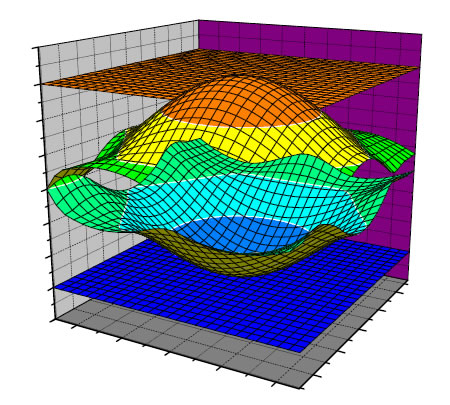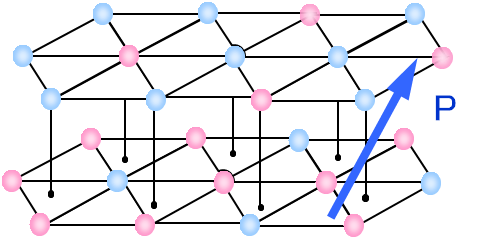Research Topics
Condensed matter systems are identified as the many-body quantum systems consisting of a macroscopic number of atoms and electrons. Because of the strong electron-electron interaction and the electron-atom interactions, various exotic phenomena, which are never expected from the few-body system and the one-body picture, emerge. In our laboratory, we study theoretically the magnetic, dielectric and optical properties, as well as the superconductivity, in the correlated electron systems. The followings are the main research themes.
Novel phenomena in correlated electron systems with multi-degrees of freedom
Electronic systems with strong Coulomb interactions, i.e. quantum many-body systems, have attracted much attention of a number of researchers. The high-Tc superconducting cuprates and the colossal magnetoresistive manganites are some examples. In insulators caused by the Coulomb interactions, such as the Mott insulators and the charge-order insulators, the electronic orbitals are partially filled, and the spin and orbital degrees of freedom remain. In the vicinity of such insulating phases, a number of novel phenomena, such as the high-Tc superconductivity and the colossal magnetoresistance, are observed.
In this theme, we study novel magnetic and dielectric phenomena and their macroscopic mechanism in correlated electron systems with the multi-degrees of freedom, i.e. spin-charge-orbital and lattice. New ordered phases (vacuums), elementary excitations (particles) and giant responses owing to phase competitions and separation are examined. Research results will provide guide-lines for the multi-functional materials in the next generation.
Recent themes:
"Novel dilution effect in orbital-ordered system"
"Ring-exchange interaction and magnetic-octupole order in orbital degenerate system"
"Electronic phase separation in spin-transition system"
 |
 |
Ring-exchange interaction and magnetic octupole order in orbital degenerate system |
Orbital pseudo-spin alignment in dilute orbital system |
 |
|
Effective interaction in the momentum space in honeycomb lattice orbital model |
|
Search for exotic ferroelectricity
Ferroelectricity is a well known phenomenon where a macroscopic electric polarization appears spontaneously. Nowadays, various ferroelectric oxides, organic compounds and liquid crystals are widely applied to the electric devices. The electric dipole moments, attributed to the permanent dipole moment, the ionic lattice distortion and a shift of the electronic cloud, are aligned due to the long-range Coulomb interactions and the electronic covalency.
In this theme, we examine theoretically the new types of the dielectric and ferroelectric materials and phenomena. The magneto-ferroelectric materials, where magnetism and ferroelectricity coexist, are one of the examples. Another example is "the electronic ferroelectricity" where a electric polarization is caused by the electronic charge order without the inversion symmetry. Here, it is expected that electron correlation effect and quantum charge fluctuation play essential roles on the stability of the ferroelectricity. This new type of ferroelectricity is expected for applications to the fast optical switching and nano devices.
Recent themes:
"Electric polarization and quantum charge fluctuation in layered iron oxides"
"Mott insulator and charge-ordered insulator in charge-transfer type organic salts"
 |
Mott insulator and charge ordered insulator in charge transfer type organic salt |
 |
Photo induced switching of electric polarization in electronic ferroelectricity |
 |
Charge order and electric dipole moment in layered iron oxide |
Novel relationship between light and matter
Recent developments of technologies in light and x-ray open new windows for the novel relationship between light and matter. The 3rd generation synchrotron-radiation sources, the free electron laser, terahertz laser technology, and the ultrafast time-resolved spectroscopy are some examples.
In this theme, we target new relation between light and correlated electron systems, and examine 1) the new experimental probes based on the recent light and x-ray technologies, and 2) hidden ordered-phase and phenomena, which are not expected in equilibrium state, by irradiation of light. We have a number of international and domestic collaborations with experimental groups, and provide theoretical interpretations for the experimental data, reveal the microscopic process in the light-matter systems, and propose new experiments.
Recent themes:
"Observation of the orbital excitation "orbiton" by the polarization-dependent resonant inelastic x-ray scattering"
"Photo-induced dynamics in spin-charge coupled systems"
"High-spin/low-spin transition by photo-irradiation in the itinerant correlated electron system"
 |
Photo irradiation in spin-charge coupled system |
 |
Real space image of charge dynamics due to photo irradiation |

